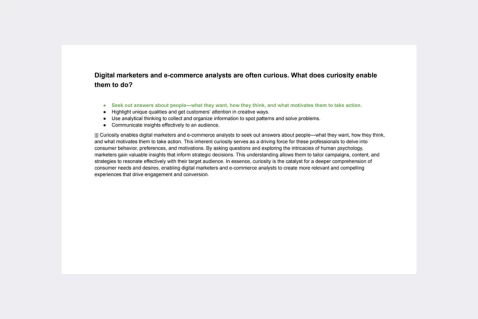A marketer creates charts and infographics as part of their data story. What is this component called?
Narrative
Story design
Data visualization
Data
Certification program: 👉 Google Digital Marketing & E-commerce Professional Certificate (Coursera)
Explanation: Data visualization is the correct term for the component where a marketer creates charts and infographics as part of their data story. Data visualization involves the use of graphical elements such as charts, graphs, and infographics to represent complex data in a visual format. This visual representation enhances the audience’s understanding of the information, making it more accessible and compelling. Unlike the narrative, which involves the storytelling aspect, or broader terms like story design, data visualization specifically refers to the graphical representation of data. It plays a crucial role in conveying key insights and patterns to the audience in a manner that is both informative and visually engaging.
Passing exams is not a workout. Multiple attempts won’t make you stronger.



- All possible certificate program questions
- Real certification exam questions
- Detailed answer explanations.
- Over 1700 questions, 7 courses, 30 quizzes
- Free lifetime updates.
Enhancing Data Communication with Visuals: The Power of Charts and Infographics
In the realm of marketing, effectively conveying data and insights is crucial for making informed decisions and telling compelling stories. While raw data can be overwhelming and difficult to comprehend, visual representations such as charts and infographics offer a powerful solution to distill complex information into easily digestible formats. Let’s delve into the significance of this component in data storytelling.
Understanding Charts and Infographics in Data Storytelling
1. Charts: Visualizing Data Trends
Charts are graphical representations of data that illustrate trends, patterns, and relationships. Whether it’s a line graph showing sales trends over time, a pie chart depicting market share, or a bar graph comparing performance metrics, charts enable marketers to present numerical data in a clear and concise manner. By choosing the appropriate chart type and formatting it effectively, marketers can enhance understanding and facilitate data-driven decision-making.
2. Infographics: Compelling Visual Narratives
Infographics combine visual elements such as charts, icons, and illustrations with concise text to convey complex information in a visually engaging format. Beyond presenting data, infographics tell a story, guiding the viewer through key insights and findings in a logical and compelling manner. Whether used in presentations, reports, or social media posts, infographics capture attention and make data more memorable and impactful.
Practical Insights for Creating Charts and Infographics
-
Know Your Audience: Consider the preferences and knowledge level of your audience when designing charts and infographics. Tailor the visuals to resonate with their interests and communication style.
-
Simplify Complex Data: Focus on highlighting the most relevant and impactful data points. Avoid cluttering charts and infographics with unnecessary information, and use visual cues to draw attention to key insights.
-
Maintain Consistency: Maintain consistency in design elements such as colors, fonts, and branding to ensure coherence across your visuals. This helps reinforce brand identity and enhances the professionalism of your communications.
-
Tell a Story: Structure your infographics as a narrative, with a clear beginning, middle, and end. Use visuals to guide the viewer through the story, leading them to the main takeaway or call to action.
-
Optimize for Sharing: When creating infographics for social media or digital channels, optimize them for easy sharing and consumption. Consider the ideal dimensions and file formats for different platforms to maximize visibility and engagement.
Conclusion: Harnessing the Power of Visual Communication
In summary, charts and infographics play a pivotal role in data storytelling, enabling marketers to communicate insights effectively and engage their audience. By leveraging these visual components, marketers can transform complex data into compelling narratives that inform, persuade, and inspire action.
Now, armed with the knowledge of how charts and infographics enhance data communication, how will you integrate these visual elements into your marketing strategies to elevate your data storytelling?
Discover our best-value guides
- Special Bundle Offer Google_Ads_Roll
- Special Bundle Offer HubSpot_Exams_Roll
- Special Offer Unchained_Guru_Roll
- Special Bundle Offer Amazon_Roll
- Special Bundle Offer Google_Analytics_Roll
- Special Bundle Offer Google_SkillShop_Roll
- Special Bundle Offer Marketing_Platforms_Roll
- Special Bundle Offer Microsoft_Advertising_Roll
- Special Bundle Offer YouTube_Roll
- Special Bundle Offer Google_Android_Roll
- Ultimate PMP certification preperation guide
- Google Cloud Professional Architect Certification Exam Answers - Ultimate Guide
- Special Bundle Offer SEMrush_Roll